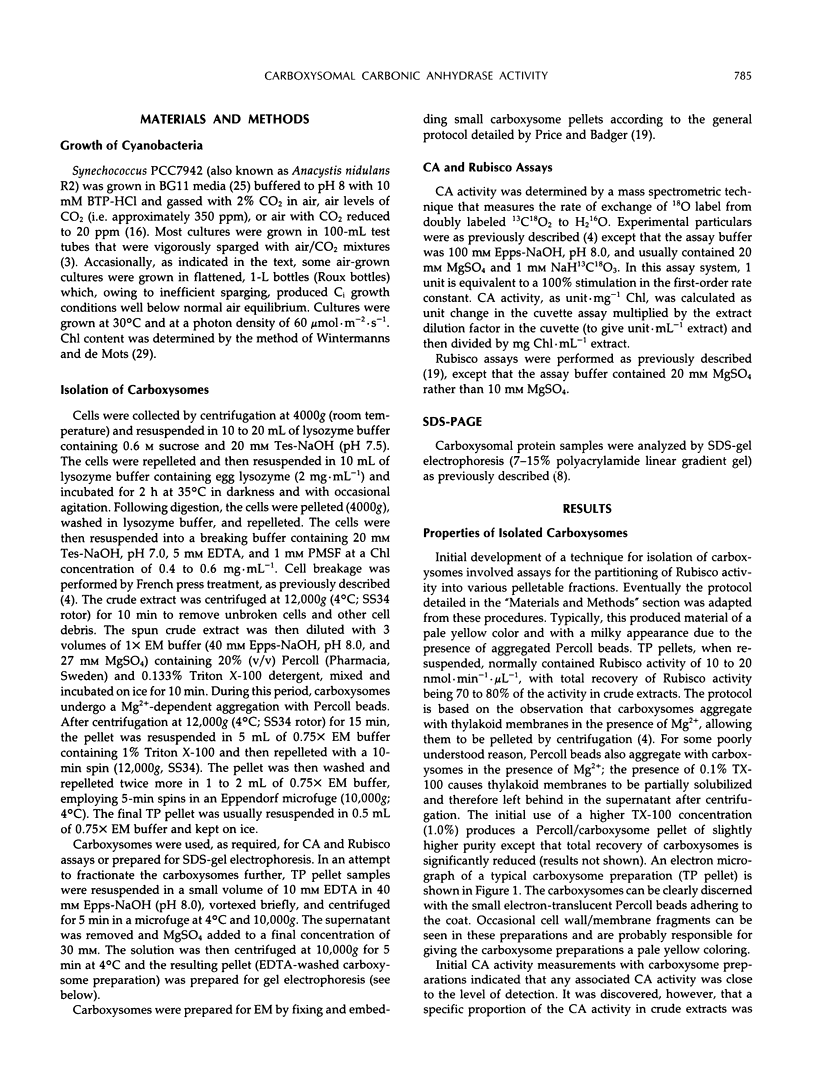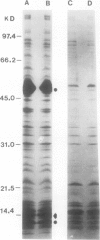Abstract
The development of a simple method for the isolation of purified carboxysomes from the cyanobacterium Synechococcus PCC7942 has made it possible to identify a specific and inducible, intracellular carbonic anhydrase (CA) activity that is strongly associated with carboxysomes. This was shown, in part, through enzyme recovery experiments that indicated that a clear majority of a CA activity that is sensitive to the CA inhibitor ethoxyzolamide (I50 = 4 μm) copurifies with a majority of the cell's ribulose-1,5-bisphosphate carboxylase/oxygenase activity in a highly purified pelletable fraction. Electron microscopy of this pelletable fraction revealed the presence of carboxysomes that were physically intact. Sodium dodecyl sulfate-polyacrylamide gel electrophoresis analysis of carboxysome proteins showed that the large and small subunits of ribulose-1,5-bisphosphate carbosylase/oxygenase were clearly prominent and that several other minor proteins could be distinguished. The specific location of this carboxysomal CA activity is further reinforced by the finding that a previously isolated high CO2-requiring mutant, Type II/No. 68 (G.D. Price, M.R. Badger [1989] Plant Physiol 91: 514-525), displayed a 30-fold reduction in carboxysome-associated CA activity when tested under optimal conditions. Carboxysomal CA has the unusual property of being inactivated by dithiothreitol. The enzyme also requires 20 mm Mg2+ (as MgSO4) for near maximum activity; other divalent cations, such as Ca2+ and Mn2+, also stimulate carboxysomal CA activity, but to a lesser extent than Mg2+. Results are discussed in relation to the role of carboxysomes in the CO2-concentrating mechanism in cyanobacteria and the role that carboxysomal CA activity appears to play in this process.
Full text
PDF









Images in this article
Selected References
These references are in PubMed. This may not be the complete list of references from this article.
- Badger M. R. Kinetic properties of ribulose 1,5-bisphosphate carboxylase/oxygenase from Anabaena variabilis. Arch Biochem Biophys. 1980 Apr 15;201(1):247–254. doi: 10.1016/0003-9861(80)90509-3. [DOI] [PubMed] [Google Scholar]
- Badger M. R., Price G. D. Carbonic Anhydrase Activity Associated with the Cyanobacterium Synechococcus PCC7942. Plant Physiol. 1989 Jan;89(1):51–60. doi: 10.1104/pp.89.1.51. [DOI] [PMC free article] [PubMed] [Google Scholar]
- Coleman J. R., Grossman A. R. Biosynthesis of carbonic anhydrase in Chlamydomonas reinhardtii during adaptation to low CO(2). Proc Natl Acad Sci U S A. 1984 Oct;81(19):6049–6053. doi: 10.1073/pnas.81.19.6049. [DOI] [PMC free article] [PubMed] [Google Scholar]
- Fukuzawa H., Suzuki E., Komukai Y., Miyachi S. A gene homologous to chloroplast carbonic anhydrase (icfA) is essential to photosynthetic carbon dioxide fixation by Synechococcus PCC7942. Proc Natl Acad Sci U S A. 1992 May 15;89(10):4437–4441. doi: 10.1073/pnas.89.10.4437. [DOI] [PMC free article] [PubMed] [Google Scholar]
- Jacobson B. S., Fong F., Heath R. L. Carbonic anhydrase of spinach: studies on its location, inhibition, and physiological function. Plant Physiol. 1975 Mar;55(3):468–474. doi: 10.1104/pp.55.3.468. [DOI] [PMC free article] [PubMed] [Google Scholar]
- Porter M. A., Grodzinski B. Regulation of chloroplastic carbonic anhydrase : effect of magnesium. Plant Physiol. 1983 Jul;72(3):604–605. doi: 10.1104/pp.72.3.604. [DOI] [PMC free article] [PubMed] [Google Scholar]
- Portis A. R., Jr, Heldt H. W. Light-dependent changes of the Mg2+ concentration in the stroma in relation to the Mg2+ dependency of CO2 fixation in intact chloroplasts. Biochim Biophys Acta. 1976 Dec 6;449(3):434–436. doi: 10.1016/0005-2728(76)90154-7. [DOI] [PubMed] [Google Scholar]
- Price G. D., Badger M. R. Ethoxyzolamide Inhibition of CO(2) Uptake in the Cyanobacterium Synechococcus PCC7942 without Apparent Inhibition of Internal Carbonic Anhydrase Activity. Plant Physiol. 1989 Jan;89(1):37–43. doi: 10.1104/pp.89.1.37. [DOI] [PMC free article] [PubMed] [Google Scholar]
- Price G. D., Badger M. R. Ethoxyzolamide Inhibition of CO(2)-Dependent Photosynthesis in the Cyanobacterium Synechococcus PCC7942. Plant Physiol. 1989 Jan;89(1):44–50. doi: 10.1104/pp.89.1.44. [DOI] [PMC free article] [PubMed] [Google Scholar]
- Price G. D., Badger M. R. Expression of Human Carbonic Anhydrase in the Cyanobacterium Synechococcus PCC7942 Creates a High CO(2)-Requiring Phenotype : Evidence for a Central Role for Carboxysomes in the CO(2) Concentrating Mechanism. Plant Physiol. 1989 Oct;91(2):505–513. doi: 10.1104/pp.91.2.505. [DOI] [PMC free article] [PubMed] [Google Scholar]
- Price G. D., Badger M. R. Isolation and Characterization of High CO(2)-Requiring-Mutants of the Cyanobacterium Synechococcus PCC7942 : Two Phenotypes that Accumulate Inorganic Carbon but Are Apparently Unable to Generate CO(2) within the Carboxysome. Plant Physiol. 1989 Oct;91(2):514–525. doi: 10.1104/pp.91.2.514. [DOI] [PMC free article] [PubMed] [Google Scholar]
- Sanyal G., Swenson E. R., Pessah N. I., Maren T. H. The carbon dioxide hydration activity of skeletal muscle carbonic anhydrase. Inhibition by sulfonamides and anions. Mol Pharmacol. 1982 Jul;22(1):211–220. [PubMed] [Google Scholar]
- Suzuki E., Fukuzawa H., Miyachi S. Identification of a genomic region that complements a temperature-sensitive, high CO2-requiring mutant of the cyanobacterium, Synechococcus sp. PCC7942. Mol Gen Genet. 1991 May;226(3):401–408. doi: 10.1007/BF00260652. [DOI] [PubMed] [Google Scholar]
- Volokita M., Zenvirth D., Kaplan A., Reinhold L. Nature of the Inorganic Carbon Species Actively Taken Up by the Cyanobacterium Anabaena variabilis. Plant Physiol. 1984 Nov;76(3):599–602. doi: 10.1104/pp.76.3.599. [DOI] [PMC free article] [PubMed] [Google Scholar]
- Wintermans J. F., de Mots A. Spectrophotometric characteristics of chlorophylls a and b and their pheophytins in ethanol. Biochim Biophys Acta. 1965 Nov 29;109(2):448–453. doi: 10.1016/0926-6585(65)90170-6. [DOI] [PubMed] [Google Scholar]
- Yu J. W., Price G. D., Song L., Badger M. R. Isolation of a Putative Carboxysomal Carbonic Anhydrase Gene from the Cyanobacterium Synechococcus PCC7942. Plant Physiol. 1992 Oct;100(2):794–800. doi: 10.1104/pp.100.2.794. [DOI] [PMC free article] [PubMed] [Google Scholar]




